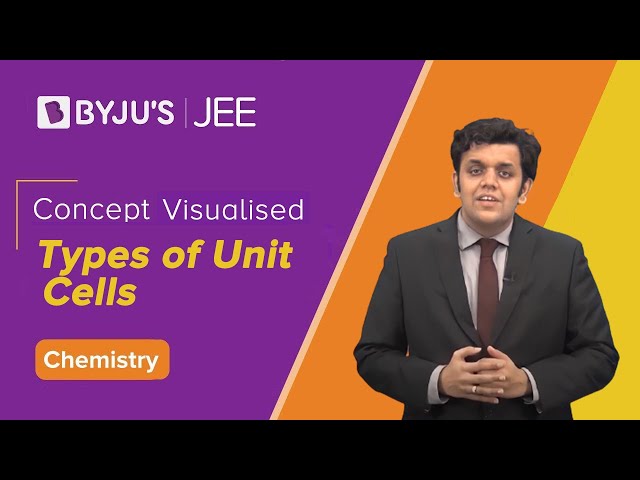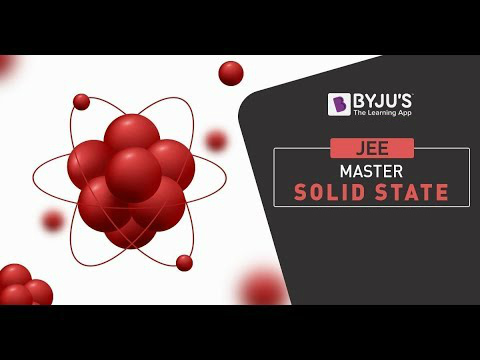Solid State JEE Advanced Previous Year Questions with Solutions provided here will help JEE aspirants to strengthen their understanding of the concepts and ultimately improve their preparation for the entrance exam. Furthermore, as students engage in solving the Solid State JEE Advanced previous year questions they can really test their understanding of the different topics given in the chapter. In essence, solving the questions and going through the solutions will really enhance the student’s grip on the topic and at the same time, they will also understand important things such as the question types, their difficulty level and the important topics.
With the questions and solutions that we have provided here, we want to ensure that you prepare in the right way and move in the right direction. We have tried to include questions from all the topics to help you understand the concepts in a clear manner. Solid State JEE Advanced Previous Year Questions with Solutions PDF is also available and can be downloaded from the tab present below.
Download Solid State Previous Year Solved Questions PDF
JEE Advanced Previous Year Questions on Solid State
Question 1. Which type of ‘defect’ has the presence of cations in the interstitial sites?
A. Vacancy defect
B. Frenkel defect
C. Metal deficiency defect
D. Schottky defect
Solution: (B)
In the Frenkel defect, the smaller cations are displaced from their actual lattice site to other interstitial sites.
Question 2. The cubic unit cell structure of a compound containing cation M and anion X is shown below. When compared to the anion, the cation has a smaller ionic radius. Choose the correct statement(s).

A. The empirical formula of the compound is MX.
B. The cation M and anion X have different coordination geometries.
C. The ratio of M-X bond length to the cubic unit cell edge length is 0.866.
D. The ratio of the ionic radii of cation M to anion X is 0.414.
Solution: (A, C)
According to the given diagram, the structure seems to be B.C.C.
(1) Empirical formula → MX
(2) C. No. of ‘M’ ion = 8 [same co-ordination Geometry]

Question 3. Consider an ionic solid MX with NaCl structure. Construct a new structure(Z) whose unit cell is constructed from the unit cell of MX following the sequential instructions given. Neglect the charge balance.
(i) Remove all the anions(X) except the central one.
(ii) Replace all the face centred cations(M) by anions(X).
(iii) Remove all the corner cations(M).
(iv) Replace the central anion(X) with cation(M).
The value of (number of anions / number of cations) in Z is ___________.
Solution: (3)
X– ⇒ Octahedral void
M+ ⇒ FCC point
(i) M+ = 4 , X– = 4 − 3 = 1
(ii) M+ = 4 − 3 = 1, X– = 1 + 3 = 4
(iii) M+ = 1 − 1 = 0, X − = 4
(iv) M+ = 0 + 1 = 1, X− = 4 − 1 = 3
So, the total number of X– in a unit cell = 3
Total number of M+ in a unit cell = 1
∴ no.of anions / no.of cations in Z = 3 / 1 = 3.
Question 4. A crystalline solid of a pure substance has a face-centred cubic structure with a cell edge of 400pm. If the density of the substance in the crystal is 8g cm-3, then the number of atoms present in 256g of the crystal is N × 1024. The value of N is.
Solution: (2)
The edge length a = 400pm = 400 × 10-10 cm
The formula for the density is
Density d = Z × M / NA× a3
8 = 4 ×M / 6.023 × 1023 × (400 × 10-10)3
The atomic mass M = 77 g mol-1
The number of atoms in 256 g of pure substance = 256 / 77 × 6.023 × 1023 = 2 × 1024
But it is equal to N × 1024.
Hence, the value of N is 2.
Question 5. The correct statement(s) for cubic close-packed (ccp) three-dimensional structure is (are)
A. The number of the nearest neighbours of an atom present in the topmost layer is 12
B. The efficiency of atom packing is 74%
C. The number of octahedral and tetrahedral voids per atom are 1 and 2, respectively
D. The unit cell edge length is 2√2 times the radius of the atom
Solution: (B, C and D)
In the middle layer (B) the atom present at the centre has 6 neighbouring atoms in the same layer (B), 3 neighbouring atoms in the top layer and 3 neighbouring atoms in the bottom layer. Total 12 neighbouring atoms. The top-most layer will have 9 nearest neighbours.

For ccp (fcc),
Number of octahedral voids = 1 × no. of the atom
Number of tetrahedral voids = 2 × no. of the atom
Hence, the number of octahedral and tetrahedral voids per atom are 1 and 2, respectively.
For edge length:
4r = √2a where ‘a’ is the edge length of the unit cell and ‘r’ is the radius of the atom.
a = 2√2r
Question 6. If the unit cell of a mineral has a cubic close-packed (ccp) array of oxygen atoms with m fraction of octahedral holes occupied by aluminium ions and n fraction of tetrahedral holes occupied by magnesium ions, m and n, respectively, are:
A. ½, ⅛
B. 1, ¼
C. ½, ½
D. ¼, ⅛
Solution: (A)
In ccp array:
Number of oxygen atoms = 4
Number of octahedral holes = 4
Number of tetrahedral holes = 8
Number of Al3+ ions = 4 × m
Number of Mg2+ ions = 8 × m
Molecule of mineral will be neutral, hence
4(−2) + 4m(+3) + 8n(+2) = 0
12m + 16n = 8
3m + 4n = 2
∴ m = ½ and n = ⅛
Question 7. A compound MpXq has cubic close packing (ccp) arrangement of X. Its unit cell structure is shown below.

A. MX
B. MX2
C. M2 X
D. M5 X14
Solution: (B)
Number of atoms of M = 1 + 4 × ¼ = 2
Number of atoms of X = ⅛ × 8 + 6 × ½ = 4
Therefore, the empirical formula is MX2.
Hence, the correct option is B.
Question 8. The number of hexagonal faces that are present in a truncated octahedral is.
Solution: (8)
The truncated octahedron is the 14-faced Archimedean solid, with 14 total faces: 6 squares and 8 regular hexagons. The truncated octahedron is formed by removing the six right square pyramids one from each point of a regular octahedron as:

Truncated octahedron

Truncated octahedron unfolded in two dimension
Question 9. The arrangement of X– ions around A+ ion in solid AX is given in the figure (not drawn to scale). If the radius of X– is 250 pm, the radius of A+ is.

A. 125 pm
B. 57 pm
C. 104 pm
D. 183 pm
Solution: (C)
According to the given figure, A+ is present in the octahedral void of X–. The given arrangement as it represents octahedral void we can write;
R +(cation) / r – (anion) = 0.414
r(A+) / r(X–) = 0.414
r(A+) = 0.414 × r(X–) = 0.414 × 250 pm
= 103.5 pm ≈ 104 pm
Question 10. The packing efficiency of the two-dimensional square unit cell shown below is:

A. 39.27%
B. 68.02%
C. 74.05%
D. 78.54%
Solution: (D)
Contribution of the circle from the comer of square = ¼
⇒ The effective number of circles per square = ¼ × 4 + 1(at centre) = 2
⇒ Area occupied by circle = 2𝜋2, r = radius
Also, diagonal of square 4r = √2L, where L = side of the square
⇒ Packing fraction = Area occupied by circles / Area of square
=2πr2 / L2 = 2πr2 / 8r2 = π / 4 = 0.785
⇒ % Packing efficiency = 78.5%
Recommended Videos
Solid State – Types of Unit Cells

Solid State Important JEE Questions and Answers

Solid State – Video Lesson

Solids and Unit Cells – JEE Concepts

Solid State – Voids in FCC and HCP

Solid State – Top 10 Most Important JEE Main Questions

Solid State Class 12 One-Shot Full Chapter Revision for JEE Main 2022

Comments